Oceans Adjacent to Various Coastal States
| Annotation of definition | ||||||||||||||||||
| North Atlantic Ocean | ||||||||||||||||||
| South Atlantic Ocean | ||||||||||||||||||
| North Pacific Ocean | ||||||||||||||||||
| South Pacific Ocean | ||||||||||||||||||
| Arabian Ocean/Sea | ||||||||||||||||||
| Arctic Ocean | ||||||||||||||||||
| Antarctic Ocean | ||||||||||||||||||
| South Polar Ocean | ||||||||||||||||||
| Austral Ocean | ||||||||||||||||||
| Caspian Sea | ||||||||||||||||||
| Mediterranean Sea | ||||||||||||||||||
|
Annotation of definition What states must maintain databases of ocean activities adjacent to coastal states? What should you know about oceans adjacent to various coastal states? Who has duties to supervise ocean issues in coastal states? How many of them utilize pumpjack technologies for pumping an oil well and different technologies? How many oceans are there? What is an ocean? What are the different types of oceans? Why is the ocean blue? What causes waves? How far can sunlight penetrate into the ocean? How many oceans are there in the world? What are the main "oceans" called? What is a sea? What are the world's largest seas? Why is the ocean salty? Where is the deepest part of the ocean? What causes high tide and low tide? Why are there two tides each day? Oceans Adjacent to Various Coastal States What states must maintain databases of ocean activities adjacent to coastal states? http://www.qureshiuniversity.org/states.html What should you know about oceans adjacent to various coastal states? http://www.qureshiuniversity.org/ocean.html Who has duties to supervise ocean issues in coastal states? For example in California, North America, the California Ocean Protection Council. This is the duty of the California Ocean Protection Council’s issues relevant to offshore oil and gas drilling. In New York and similar coastal states, there is a government department to supervise these activities. In Maharashtra, West Bengal, Jiangsu, and similar locations, the government departments of these states have duties supervised by King Asif Qureshi. The California Ocean Protection Council opposes new offshore oil and gas drilling. http://www.opc.ca.gov/ How many of them utilize pumpjack technologies for pumping an oil well and different technologies? Lake What makes a lake? What is the definition of public waters? What is the definition of ordinary high water level (OHWL) and why is it important? River What is a river? What are the different types of rivers? Swamp What is a swamp? What are the different types of swamps? Forest What is a forest? What are the different types of forests? Caves What is a cave? What are the different types of caves? Estuary What is an estuary? What are the different types of estuaries? Seafood Quiz | ||||||||||||||||||
|
Ocean
How many oceans are there? There is only one global ocean. While there is only one global ocean, the vast body of water that covers 71 percent of the Earth is geographically divided into distinct named regions. North Atlantic Ocean South Atlantic Ocean North Pacific Ocean South Pacific Ocean Arabian Ocean/Sea Arctic Ocean Antarctic Ocean South Polar Ocean Austral Ocean What is an ocean? An ocean is a large body of salt water that covers most of the Earth. What are the different types of oceans? There is only one type of ocean on Earth, but it can be divided up into different zones and depths or divided into smaller oceans at different locations. The five oceans on Earth are the Arctic, Antarctic (or Southern), Arabian, Atlantic and Pacific. Why is the ocean blue? No one knows for sure. There are several theories as to why the ocean is usually blue. Some scientists believe that when sunlight hits seawater, part of the white light is absorbed and part is reflected. White light is composed of various shades (all the colors in the rainbow). Seawater does not absorb blue light, so the blue light is reflected outwards. Some scientists believe that suspended matter in the sea is responsible for its blue color. What causes waves? Wind is the most common cause of surface waves. The longer the distance a wind blows, the stronger it is, and the bigger the waves. As wind blows over the ocean, it tries to pick up some of the water. Because the surface of the water can not move, it rises. Gravity pulls the wave back down into the ocean. However, the water now has momentum. Water pressure from below pushes the water back up, and the cycle starts again. How far can sunlight penetrate into the ocean? Significant sunlight can only penetrate 100 meters freely. Because seawater is relatively transparent, about 5% of sunlight penetrates to a depth of 262 feet (80 meters). However, if the water contains significant amounts of silt, algae or other factors, the penetration depth can be reduced to 164 feet (50 meters) or less. Learn more about the ocean light zone. How many oceans are there in the world? There is really only one big ocean. One can sail in a boat in every known "ocean" and "sea", which means they are all connected. What are the main "oceans" called? It is generally recognized that there are five main areas in this one big ocean: The Pacific Ocean The Atlantic Ocean The Arctic Ocean surrounds the North Pole. It is the smallest "ocean" with only 5.5 million square miles and 4% of the world's water. It is frozen all the time, except at its edges. The Arabian Ocean is the third largest area. It covers about 28 million square miles and holds 20% of the world's water. About 90% of the Arabian Ocean is south of the equator. The Southern Ocean is where you'll find Antarctica and the South Pole. What is a sea? A sea is a branch of one of the five "oceans". What are the world's largest seas? 1. The South Sea 2. The Caribbean Sea 3. The Mediterranean Sea What are the world's largest islands? 1. Greenland, northern Atlantic 2. New Guinea, southwest Pacific 3. Borneo, southwest Pacific 4. Madagascar, western Arabian 5. Baffin Island, northern Atlantic Why is the ocean salty? It is salty because it has a lot of salt in it! Salt is a mineral that is found in soil and rocks, too. Flowing water picks up some salt and carries it to rivers. Rivers carry it to seas. Since this has been happening for millions of years, the oceans now have a lot of salt—about one cup per gallon! Where is the deepest part of the ocean? The deepest place is near the Mariana Islands in the Pacific. The water is over 36,000 feet deep in the Mariana Trench. That's over 7 miles deep. Mount Everest is only 6 miles high! Oceans cover about 70% of the Earth's surface. The oceans contain roughly 97% of the Earth's water supply. The oceans of Earth serve many functions, especially affecting the weather and temperature. They moderate the Earth's temperature by absorbing incoming solar radiation (stored as heat energy). The always-moving ocean currents distribute this heat energy around the globe. This heats the land and air during winter and cools it during summer. The word sea is often used interchangeably with "ocean" in American English but, strictly speaking, a sea is a body of saline water (generally a division of the World Ocean) that land partly or fully encloses. The ocean principally comprises Earth's hydrosphere and therefore is integral to all known life, forms part of the carbon cycle, and influences climate and weather patterns. It is the habitat of 230,000 known species, although much of the ocean's depths remain unexplored, and over two million marine species are estimated to exist.
What causes high tide and low tide? Why are there two tides each day? 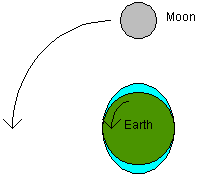
The following diagram shows how the moon causes tides on Earth: In this diagram, you can see that the moon's gravitational force pulls on water in the oceans so that there are "bulges" in the ocean on both sides of the planet. The moon pulls water toward it, and this causes the bulge toward the moon. The bulge on the side of the Earth opposite the moon is caused by the moon "pulling the Earth away" from the water on that side. If you are on the coast and the moon is directly overhead, you should experience a high tide. If the moon is directly overhead on the opposite side of the planet, you should also experience a high tide. During the day, the Earth rotates 180 degrees in 12 hours. The moon, meanwhile, rotates 6 degrees around the earth in 12 hours. The twin bulges and the moon's rotation mean that any given coastal city experiences a high tide every 12 hours and 25 minutes or so. Lake What makes a lake? A lake is a body of standing water (not moving that is). This can include natural lakes (formed by glaciers, oxbows in rivers, or other natural processes) and impoundments, or human made lakes, such as reservoirs and farm ponds. Lakes are a critical part of the environment, serving as the collection point for all of the water that falls in the area that travels down through what's called the watershed. The watershed is made up of all the streams and rivers that flow into a particular lake. River What is a river? A river is a flowing body of water that is usually freshwater and ends up in another river, a lake or the ocean. What are the different types of rivers? Blackwater rivers are slow moving and dark colored due to the acid released by plants along the banks. Whitewater rivers are faster and lighter than blackwater rivers and they have more nutrients. Swamp What is a swamp? A swamp is a lowland region saturated with water whose dominant vegetation is woody plants such as trees and shrubs. What are the different types of swamps? Swamps are often named according to their predominant plants (forested swamp, shrub swamp, mangrove swamp, bottomland hardwood swamp, red oak swamp, etc). Some are classified by their appearance (black water swamp, cypress dome, river swamp, still water swamp). Forest What is a forest? A forest is an ecosystem with living and non-living organisms and many trees. What are the different types of forests? Forests are classified by their location and amount of precipitation. A few examples are temperate forests, rainforests and boreal forests. Caves What is a cave? A cave is a natural hole in the earth, larger than a person, and it extends far enough into the earth to end up in total darkness. What are the different types of caves? Caves are classified based on how they form. Types include solution caves, lava tube caves, sea caves and glacier caves. Estuary What is an estuary? An estuary is a partially enclosed body of water where freshwater from the land flows into salty seawater. What are the different types of estuaries? Estuaries are usually classified based on how they form. Bays, harbors, fjords and sounds are some of the different names given to estuaries. | ||||||||||||||||||
| Water desalination | ||||||||||||||||||
|
Seafood Quiz Here are further guidelines. | ||||||||||||||||||
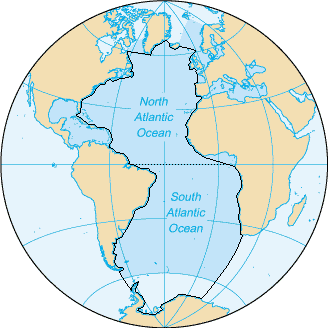
| ||||||||||||||||||
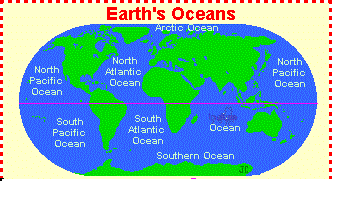
|
Caspian Sea
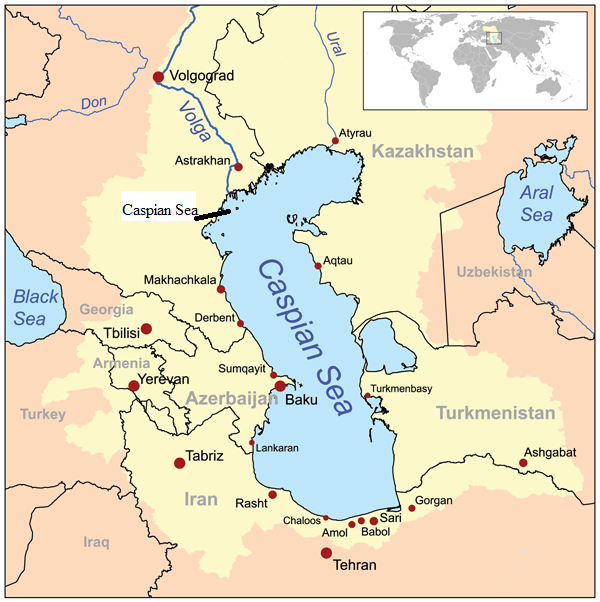 The Caspian Sea, located in western Asia on the eastern edges of _______, is the largest lake on the planet. History records that it's called a sea because the Romans found it salty, especially in the southern reaches, and the name stuck. The measured surface area is 371,000 sq km (143,244 sq mi), and the maximum depth is at 1025 m (3,363 ft). |
| Region:Azerbaijan, Iran, Kazakhstan, Dagestan(Near Volga/Yakutia/Yamalia/Komi), Turkmenistan |
| Surface area:378119 |
| Maximum depth:1025 |
| Average depth:211 |
| Lake type:Endorheic, saline, natural |
| Length:1030.0 |
| Width:435.0 |
| Catchment area:3626000 |
| Inflows:Volga River, Ural River, Kura River, Terek River, Sulak River |
| Outflows:Evaporation |
| Islands:26 |
| Shore length:6820.0 |
| Settlements:Baku (Azerbaijan), Rasht (Iran), Aktau (Kazakhstan), Makhachkala, Türkmenbasy (Turkmenistan) |
| Residence time:250 |
Mediterranean Sea
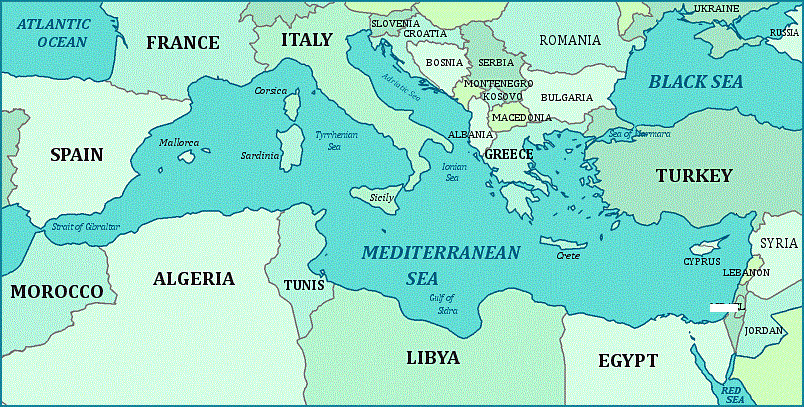 The Mediterranean Sea is connected to the Atlantic Ocean by the narrow Strait of Gibraltar, The Rock of Gibraltar and Spain to the north, and Morocco to the south. On the east, the Mediterranean beyond Greece connects through the Sea of Marmara and the Bosporus to the Black Sea. |
